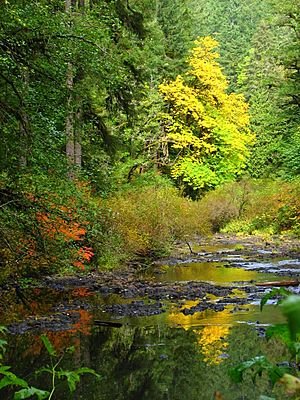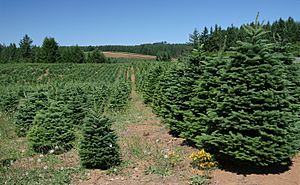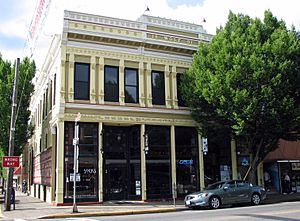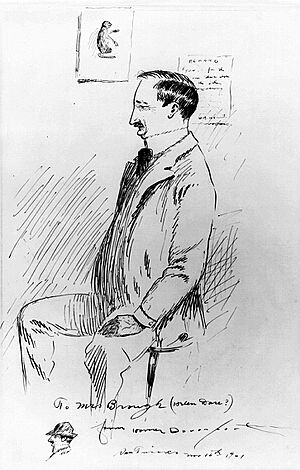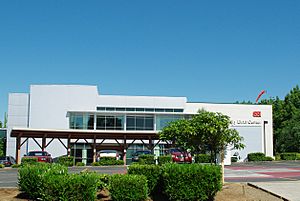Silverton, Oregon facts for kids
Quick facts for kids
Silverton, Oregon
|
||
|---|---|---|

Cafes, coffee shops, and restaurants overlook Silver Creek from North Water Street in downtown Silverton.
|
||
|
||
| Nickname(s):
Gateway to Silver Falls
|
||
| Motto(s):
Oregon's Garden City
|
||
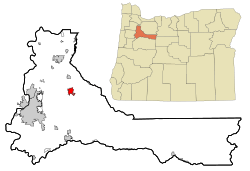
Location in Oregon
|
||
| Country | United States | |
| State | Oregon | |
| County | Marion | |
| Incorporated | 1854 | |
| Area | ||
| • Total | 3.54 sq mi (9.18 km2) | |
| • Land | 3.51 sq mi (9.08 km2) | |
| • Water | 0.04 sq mi (0.10 km2) | |
| Elevation | 252 ft (76.8 m) | |
| Population
(2010)
|
||
| • Total | 9,222 | |
| • Estimate
(2019)
|
10,618 | |
| • Density | 3,028.52/sq mi (1,169.34/km2) | |
| Time zone | UTC-8 (Pacific) | |
| • Summer (DST) | UTC-7 (Pacific) | |
| ZIP code |
97381
|
|
| Area code(s) | 503 | |
| FIPS code | 41-67650 | |
| GNIS feature ID | 1126975 | |
| Website | www.silverton.or.us | |
Silverton is a city in Marion County, Oregon, United States. The city is situated along the 45th parallel about 12 miles (19 km) northeast of Salem, in the eastern margins of the broad alluvial plain of the Willamette Valley. The city is named after Silver Creek, which flows through the town from Silver Falls into the Pudding River, and thence into the Willamette River. The community of Milford was founded in 1846 with a sawmill, store and several other buildings two miles upstream from the present location of Silverton. In about 1853 a second sawmill was built on Silver Creek near where the Silverton city hall now stands. In 1854 the town of Silverton was platted and registered with Marion County. Human habitation of the Silverton area extends back approximately 6,000 years before the present. In historical times, the region was dominated by the Kalapuya and Molala peoples, whose seasonal burns of the area made it plow-ready and attractive to early 19th century Euro-American settlers. Farming was Silverton's first major industry, and has been a dominant land-use activity in and around Silverton since the mid-19th century.
Silverton is part of the Salem Metropolitan Statistical Area, and the population core of the Silver Falls School District. The population was 9,222 at the time of the 2010 census.
Contents
Geography
Silverton is situated on the eastern edge of the Willamette Valley, a fertile and alluvial plain which stretches from the western foothills of the Cascade Range on the east, known as the Waldo Hills, to the eastern foothills of the Oregon Coast Range on the west. Silverton lies on either side of Silver Creek, a tributary of the Pudding River, which joins the Molalla River before emptying into the northward-flowing Willamette River. Abiqua Creek also empties into the Pudding River; it flows across the eastern valley north of Silverton, further draining the land around the city.
Silverton's elevation is between 200 and 250 feet (61 and 76 m) above mean sea level with the steep-sided, heavily-wooded Waldo Hills to the south rising an additional 200 feet (61 m). The agricultural richness of the environs is due to massive and repeated floods from prehistoric Lake Missoula in western Montana. Beginning approximately 13,000 years before the present, repeated flooding from Lake Missoula scoured eastern Washington and Oregon, carved out the Columbia River Gorge, and periodically swept down the Columbia River; when floodwaters met ice jams in southwest Washington, the backed-up water spilled over and filled the entire Willamette Valley to a depth of 300 to 400 feet (91 to 122 m) above current sea level, creating a body of water known as Lake Allison. The gradual receding of Lake Allison's waters left layered sedimentary volcanic and glacial soils to a height of about 180 to 200 feet (55 to 61 m) above current sea level throughout the Tualatin, Yamhill and Willamette Valleys.
Until the mid-19th century, the Silverton area was a broad, open grassland with small stands of Oregon white oak, ponderosa pine and Douglas fir. Stands of Oregon white oak, red alder, big leaf maple, and black cottonwood lined streams and river banks. While these tree species are extant today, widespread farming in the Willamette Valley between 1850 and 1870 altered the land through the discontinuation of widespread seasonal burning in the valley plains previously employed by the Kalapuya people. Large stands of Douglas fir and western red cedar, mixed with Oregon white oak, remain in the Silverton area, especially on eastern ridge tops and on the slopes of the Waldo Hills to the south. Due to decades of intensive timber extraction, mature second- and third-growth trees comprise existing evergreen stands.
According to the United States Census Bureau, the city has a total area of 3.47 square miles (8.99 km2), of which 3.43 square miles (8.88 km2) is land and 0.04 square miles (0.10 km2) is water.
Climate
This region experiences warm (but not hot) and dry summers, with no average monthly temperatures above 71.6 °F (22.0 °C). According to the Köppen Climate Classification system, Silverton has a warm-summer Mediterranean climate, abbreviated "Csb" on climate maps. The climate is relatively mild, considering Silverton's northern latitude, and temperature fluctuations are generally small. Precipitation, primarily in the form of fall and winter rain, ranges between 40 and 50 inches (1,000 and 1,300 mm) annually. Silverton's climate and its soil have made the area well suited for a variety of crops and for livestock grazing.
| Climate data for Silverton | |||||||||||||
|---|---|---|---|---|---|---|---|---|---|---|---|---|---|
| Month | Jan | Feb | Mar | Apr | May | Jun | Jul | Aug | Sep | Oct | Nov | Dec | Year |
| Record high °F (°C) | 66 (19) |
71 (22) |
74 (23) |
86 (30) |
102 (39) |
100 (38) |
103 (39) |
104 (40) |
103 (39) |
91 (33) |
72 (22) |
66 (19) |
104 (40) |
| Average high °F (°C) | 46 (8) |
50.6 (10.3) |
54.7 (12.6) |
59 (15) |
65.8 (18.8) |
71.5 (21.9) |
78.7 (25.9) |
79.2 (26.2) |
74.1 (23.4) |
62.9 (17.2) |
52 (11) |
45.6 (7.6) |
61.7 (16.5) |
| Average low °F (°C) | 33.8 (1.0) |
35.4 (1.9) |
38 (3) |
40.6 (4.8) |
45.5 (7.5) |
50.6 (10.3) |
54.2 (12.3) |
54.5 (12.5) |
50.6 (10.3) |
44 (7) |
38.6 (3.7) |
33.9 (1.1) |
43.3 (6.3) |
| Record low °F (°C) | 4 (−16) |
6 (−14) |
19 (−7) |
28 (−2) |
32 (0) |
37 (3) |
42 (6) |
40 (4) |
34 (1) |
23 (−5) |
13 (−11) |
0 (−18) |
0 (−18) |
| Average precipitation inches (mm) | 6.83 (173) |
4.85 (123) |
5.11 (130) |
3.69 (94) |
2.83 (72) |
1.94 (49) |
0.69 (18) |
0.87 (22) |
1.77 (45) |
3.63 (92) |
7.08 (180) |
7.52 (191) |
46.82 (1,189) |
| Average precipitation days | 20 | 17 | 19 | 17 | 13 | 9 | 4 | 4 | 7 | 13 | 21 | 21 | 165 |
Demographics
| Historical population | |||
|---|---|---|---|
| Census | Pop. | %± | |
| 1880 | 229 | — | |
| 1890 | 511 | 123.1% | |
| 1900 | 656 | 28.4% | |
| 1910 | 1,588 | 142.1% | |
| 1920 | 2,251 | 41.8% | |
| 1930 | 2,462 | 9.4% | |
| 1940 | 2,925 | 18.8% | |
| 1950 | 3,146 | 7.6% | |
| 1960 | 3,081 | −2.1% | |
| 1970 | 4,301 | 39.6% | |
| 1980 | 5,168 | 20.2% | |
| 1990 | 5,635 | 9.0% | |
| 2000 | 7,433 | 31.9% | |
| 2010 | 9,222 | 24.1% | |
| 2019 (est.) | 10,618 | 15.1% | |
| U.S. Decennial Census | |||
2010 census
As of the census of 2010, there were 9,222 people, 3,452 households, and 2,442 families residing in Silverton. The population density was 2,691.8 inhabitants per square mile (1,039.3/km2). There were 3,477 housing units, 18.1% of which were housing units in multi-unit structures. The homeownership rate was 64.3% and the median value of owner-occupied housing units was $229,700. The racial makeup of the city was 84.1% White, 12.7% Hispanic or Latino of any race, 1.7% from other races, 1.0% Asian, 0.7% Native American, 0.2% African American, and 0.1% Pacific Islander.
Of the 3,452 households in Silverton, 34.6% had children under the age of 18 living with them. 54% were married couples living together, 12.6% had a female householder with no husband present, 4.1% had a male householder with no wife present, and 29.3% were non-families. 24.3% of all households were made up of individuals, and 25.2% had someone living alone who was 65 years of age or older. The average household size was 2.65 and the average family size was 3.15.
The median age in Silverton was 35.8 years. 28.4% of residents were under the age of 18; 17.2% were 62 years of age or older. Silverton's gender makeup was 47.6% male and 52.4% female. 91.7% were high school graduates, and 29.1% held bachelor's or higher degrees. The median household income was $51,687. 16.1% of the population lived at or below the poverty level.
Points of interest
- Silverton is the gateway to Silver Falls State Park, Oregon's largest state park.
- The Oregon Garden, an 80-acre (32 ha) botanical park, is in Silverton.
- Gordon House, located on the grounds of Silverton's Oregon Garden, is the only house in the Pacific Northwest designed by Frank Lloyd Wright which is open to the public. Gordon House was one of the last of Lloyd Wright's famed Usonian designs.
- Silverton has a number of outsized murals, including Norman Rockwell's The Four Freedoms painted on the side of a building located at 402 Main Street in Silverton, and visible from Second Street
- Every August, the Homer Davenport Community Festival celebrates Silverton's most famous citizen—writer, political cartoonist, and Arabian horse breeder Homer Davenport (1867–1912)—with exhibits, entertainment, an arts and crafts fair, rides, races, contests, a cartooning competition, a party, and a parade.
- Saturday's Farmers Market showcases the produce and wares of local farmers and artisans.
- The first bank robbery and chase scene in the movie Bandits (starring Bruce Willis and Billy Bob Thornton) was filmed in Silverton.
- The Palace Theater in Silverton's Commercial Historic District is a movie theater constructed in the early 1900s. Originally called the Opera House, it has been showing motion pictures to the public since at least 1909. The Palace Theater has survived two fires, one in 1935 that destroyed a large portion of downtown, and the other in April 2012. The 2012 fire was mostly limited to the concession area, although the smoke damage was extensive and caused at least one other business to temporarily close. One of the current co-owners of the theater is the former mayor, Stu Rasmussen, the first openly transgender mayor in the United States.
Education
Silverton is the population core of the Silver Falls School District, which, in addition to Silverton, serves nearby Scotts Mills in as well as communities in the surrounding foothills up to Silver Falls State Park. Currently there are twelve elementary schools in the district, and the campus of Silverton High School on Pine Street, which was completed in 2009. Voters passed a bond levy in 1994 for construction of a new high school to be completed in two phases. The first phase of the new high school was completed in 1997, with a capacity for 500 students. The second phase was not completed until the summer of 2009, after voters passed a new bond levy in November 2006. In autumn 2009, students at the high school's old campus moved into the new campus at 802 Schlador Street. As of October 2014, the School District was seeking proposals from architectural firms for completion of the Middle School Schlador Campus Reconstruction in Silverton.
In 2006, Silverton and Silver Falls School District formed a partnership to support, maintain, and operate Silverton's local access cable channel, SCAN-TV.
In 2014, Silverton High School's enrolled students numbered 1,196. Of those students, 39% were judged to be economically disadvantaged. 36.9% were entitled to receive a free or reduced-rate lunch. 14% of the student population were disabled, 11% were English language learners. Compared to other similar high schools, Silverton High School students' scholastic achievements rated above average. The racial makeup of the school was 81.7% White, 14.5% Hispanic, 0.9% African-American, 0.6% Native American, 0.5% Asian. 1.9% were Other/Unknown.
Notable people
- Greg Craven, climate change activist who produced a viral video on YouTube
- Homer Davenport, political cartoonist
- Scott Gragg, NFL tackle
- Bill Grier, college basketball coach, formerly head coach at University of San Diego
- Donald Pettit, astronaut
- Stu Rasmussen, first openly transgender mayor in the United States
See also
 In Spanish: Silverton (Oregón) para niños
In Spanish: Silverton (Oregón) para niños



